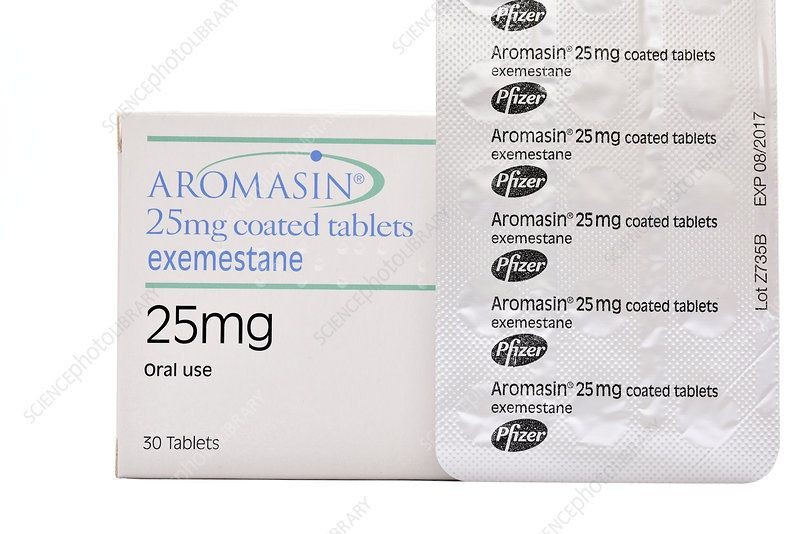
Contents
Exemestane
Exemestane belongs to the drug class aromatase inhibitors, which block the activity of aromatase, an enzyme important in the biosynthesis of estrogens, the female sex hormones.
Estrogens are steroid hormones that come in three forms: estrone (E1), estradiol (E2), and estriol (E3). Estrogens are essential for normal sexual development and function. However, they stimulate and maintain the growth of most breast cancers. Exemestane helps prevent, halt, or slow down the progression of estrogen-dependent breast cancers.
In postmenopausal women, the ovaries stop producing estrogens, and estrogens derive from male sex hormones produced by the adrenal gland. Aromatase converts these male hormones into estrogens. By inhibiting aromatase, exemestane reduces the availability of estrogens that cancer cells require to grow.
Uses of exemestane:
- Treatment of advanced breast cancer in postmenopausal women after tamoxifen therapy
- Adjuvant treatment of estrogen receptor (ER)-positive early breast cancer in postmenopausal patients who have received 2 to 3 years of tamoxifen
- Adjuvant therapy in combination with ovarian function suppression for high-risk hormone-positive breast cancer in premenopausal women
- First-line adjuvant treatment for early ER-positive breast cancer in postmenopausal women
- Risk reduction for invasive breast cancer in postmenopausal women
Warnings
- Do not use in patients with known hypersensitivity to exemestane or any of its components.
- Do not use exemestane during pregnancy, as it can cause loss of pregnancy or fetal harm.
- If used in premenopausal women, verify pregnancy status before initiation of therapy and do not administer to pregnant women.
- If pregnancy occurs during treatment, inform the patient of potential hazards to the fetus and the risk of pregnancy loss.
Side Effects of Exemestane
Common side effects include:
- Fatigue
- Hot flashes
- Pain
- Headache
- Insomnia
- Depression
- Joint pain
- Low count of lymphocyte white blood cells
- Increase in serum alkaline phosphatase
- Nausea
- High blood pressure
- Chest pain
- Coronary artery disease
- Reduced blood flow to the heart
- Heart attack
- Swelling
- Hair loss
- Excessive sweating
- Skin reactions
Less common side effects include:
- Hypersensitivity reaction
- Heart failure
- Thromboembolism
- Gastric ulcer
- Elevated liver enzymes
- Liver inflammation
- Impaired bile flow
- Overgrowth of inner uterine membrane
- Endometrial polyps
- Nerve disease
- Trigger finger
- Decreased bone mineral density
- Abnormal bone growth
- Hives
- Severe skin disorder
Contact your doctor immediately if you experience any of the following symptoms or serious side effects:
- Fast or pounding heartbeats
- Shortness of breath
- Severe headache
- Confusion
- Severe weakness
- Vomiting
- Loss of coordination
- Stiff muscles
- Fever
- Tremors
- Blurred vision
- Eye pain or swelling
This is not a complete list of side effects or adverse reactions. Contact your doctor for medical advice about serious side effects or adverse reactions. You may also report side effects or health problems to the FDA at 1-800-FDA-1088.
Dosages of Exemestane
Tablet
Adult:
Postmenopausal ER-Positive Breast Cancer
- 25 mg orally once a day; continue until tumor progression
Breast Cancer Adjuvant Treatment
- Switch to exemestane after 2-3 years of tamoxifen treatment
- 25 mg orally once a day; continue until tumor progression
- Take after meals
- 2013 American Society of Clinical Oncology (ASCO) guidelines suggest exemestane as an alternative to tamoxifen or raloxifene to prevent invasive breast cancer in high-risk women
- 25 mg orally once a day for 5 years
Dosage Modifications
- Coadministration with potent CYP3A4 inducers: 50 mg orally once a day
Dosing Considerations
- A high risk of breast cancer is defined as at least 1 breast biopsy showing lobular carcinoma in situ (LCIS) or atypical hyperplasia, 1 or more first-degree relatives with breast cancer, or a 5-year predicted risk of breast cancer greater than 1.66% (based on the modified Gail model)
Pediatric:
- Safety and efficacy not established
Overdose
- In clinical trials, dosages of up to 800 mg single dose in healthy women volunteers and up to 600 mg daily for 12 weeks in postmenopausal women with breast cancer were well tolerated. Convulsions and death occurred at extremely high doses in animal studies.
- There is no specific antidote for exemestane. Overdose is treated with symptomatic and supportive care, including monitoring of vital signs.
Drug Interactions with Exemestane
Inform your doctor of all medications you are currently taking to check for possible drug interactions. Do not begin or discontinue any medication without your doctor’s recommendation.
- Exemestane has no known severe interactions with other drugs.
- Serious interactions of exemestane include: abametapir, apalutamide, enzalutamide, ethinylestradiol, fexinidazole, idelalisib, ivosidenib, tucatinib, and voxelotor.
- Other interactions include: bazedoxifene/conjugated estrogens, conjugated estrogens, conjugated estrogens (vaginal), and hydrocortisone.
The interactions listed are not exhaustive. For more information, consult the RxList Drug Interaction Checker.
Always inform your doctor of all prescription and over-the-counter medications you use, including the dosage of each. Keep a list of this information. Contact your doctor or healthcare provider if you have any questions about the medication.
Pregnancy and Breastfeeding
- No studies of exemestane use in pregnant women exist, but animal studies show it can cause fetal harm.
- Exemestane may impair fertility in both males and females.
- Women of pregnancy potential should be tested for pregnancy before starting exemestane and avoid the drug while pregnant.
- Women of pregnancy potential should use effective contraception during exemestane therapy and for one month after the final dose.
- Exemestane’s presence in breast milk is unknown, but many drugs are excreted in breast milk. Women should not breastfeed while on exemestane therapy and for one month following the final dose due to the potential for serious adverse reactions in the breastfed infant.
Important Points about Exemestane
- Take exemestane exactly as prescribed.
- Store it safely out of reach of children.
- In case of overdose, seek medical help or contact Poison Control.
Subscribe to MedicineNet’s Cancer Report Newsletter
By clicking "Submit," I agree to the MedicineNet Terms and Conditions and Privacy Policy. I also agree to receive emails from MedicineNet and understand that I may opt out of MedicineNet subscriptions at any time.
Summary
Exemestane is a medication approved for the treatment of advanced breast cancer in postmenopausal women and used off-label to prevent breast cancer in high-risk premenopausal women. Common side effects include fatigue, hot flashes, pain, headache, insomnia, depression, joint pain, low lymphocyte count, nausea, high blood pressure, chest pain, and others. Do not take it if pregnant or breastfeeding.


